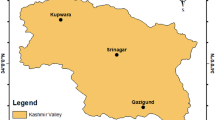Summary
The FAO modified Penman equation has gained acceptance as a standard method of estimating reference crop evapotranspiration. Although theoretically sound the Penman equation becomes increasingly empirical when parameters or variables have to be estimated. When evapotranspiration estimates are being used for practical purposes the uncertainties introduced by these empirical factors and relationships should not be neglected. Evapotranspiration estimates for north-east Sri Lanka are used to illustrate the importance of the empiricisms in the FAO modified Penman equation. It is shown that the different empirical relationships used to estimate net radiation and the wind function in the FAO modified Penman equation and in the Penman (1963) equation produce a 23% difference in the estimate of annual reference crop evapotranspiration.
Similar content being viewed by others
References
Batchelor CH, Roberts J (1983) Evaporation from the irrigation water, foliage and panicles of paddy rice in north-east Sri Lanka. Agric Meteorol 29:11
Brunt D (1934) Physical and Dynamical Meteorology. Cambridge University Press, London, p 411
Budyko MI (1956) The Heat Balance of the Earth's Surface, translated by N. I. Stepanova, US Weather Bureau, Washington
Cuenca HC, Nicholson MT (1982) Application of Penman equation wind function. J Irrig Drain Div ASCE 108:13
Doorenbos J, Pruitt WO (1975) Crop Water Requirements. Irrigation and Drainage Paper No. 24, FAO, Rome
Doorenbos J, Pruitt WO (1977) Crop Water Requirements. Irrigation and Drainage Paper No. 24 (Revised), FAO, Rome
Edwards KA, Rodda JC (1970) A preliminary study of the water balance of a small clay catchment. J Hydrol (NZ) 9:202
Fitzpatrick EA, Stern WR (1965) Components of the radiation balance of irrigated plots in a dry monsoonal environment. J Appl Meteorol 4:649
Frére M, Popov GF (1979) Agrometeorological Crop Monitoring and Forecasting. Plant Production and Protection Paper No. 17, FAO, Rome
Gerber JF, Decker WL (1961) Evapotranspiration and heat budget of a corn field. Agron J 58:259
Goss JR, Brooks FA (1956) Constants for empirical expressions for downcoming atmospheric radiation under cloudless sky. J Meteorol 13:482
Holmes DW, Dawson RJ, Gunston H, Batchelor CH (1980) Water management study at Kaudulla Irrigation Scheme, Sri Lanka, HRS Report OD29
Joshua WD (1977) Procedures for computation of irrigation duty in project design. Sri Lanka Irrigation Dept Internal Report
Monteith JL (1965) Evaporation and environment. Symp Soc Expl Biol 19:205
Monteith JL (1973) Principles of Environmental Physics. Edward Arnold, London, p 241
Monteith JL, Szeicz G (1962) Radiative temperature in the heat balance of natural surfaces. Q J R Meteorol Soc 88:496
Penman HL (1949) The dependence of transpiration on weather and soil conditions. J Soil Sci 1:74
Penman HL (1952) Experiments on the irrigation of sugar beet. J Agric Sci 42:286
Penman HL (1956) Evaporation: an introductory survey. Neth J Agric Sci 4:9
Penman HL (1963) Vegetation and hydrology. Tech Comm 53, Commonwealth Bureau of Soils, Harpenden
Prescott JA (1940) Evaporation from a water surface in relation to solar radiation. Trans R Soc Aust 64:114–125
Pruitt WO, Doorenbos J (1977) Empirical calibration, a requisite for evapotranspiration formulae based on daily or longer mean climatic data? International Conference on Evapotranspiration, I.C.I.D., Budapest
Stanhill G (1961) A comparison of methods calculating potential evapotranspiration from climatic data. Isr J Agric Res 11:159
Stigter CJ (1979) Comparison and combination of two recent proposals for a generalized Penman equation. Q J R Meteorol Soc 105:1071
Stigter CJ (1980) Assessment of the quality of generalized wind functions in Penman's equations. J Hydrol 45:321
Stigter CJ (1983) Discussion on “Application of Penman equation wind function”. J Irrig Drain Div ASCE 109:278
Thom AS, Oliver HR (1977) On Penman's equation for estimating regional evaporation. Q J R Meteorol Soc 103:345
Van Bavel CHM, Wilson TV (1952) Evaporation estimates as critical for determining time of irrigation. Agric Eng 33:417
Wang JY, Wang SC (1962) A simple graphical approach to Penman's method for evaporation estimates. J Appl Meteorol I:582
Weiss A (1983) A quantitative approach to the Pruitt and Doorenbos version of the Penman equation. Irrig Sci 4:267
Wright JL, Jensen ME (1972) Peak water requirements of crops in southern Idaho. J Irrig Drain Div ASCE 96:193
Author information
Authors and Affiliations
Rights and permissions
About this article
Cite this article
Batchelor, C.H. The accuracy of evapotranspiration estimated with the FAO modified penman equation. Irrig Sci 5, 223–233 (1984). https://doi.org/10.1007/BF00258176
Received:
Issue Date:
DOI: https://doi.org/10.1007/BF00258176




